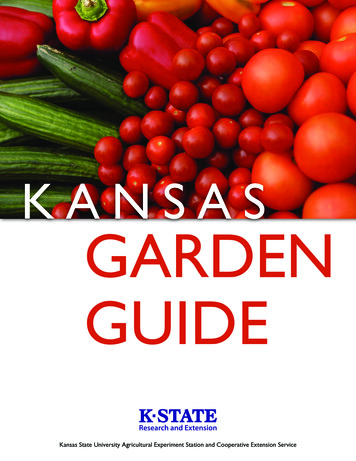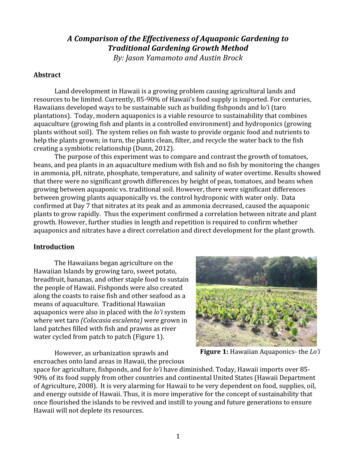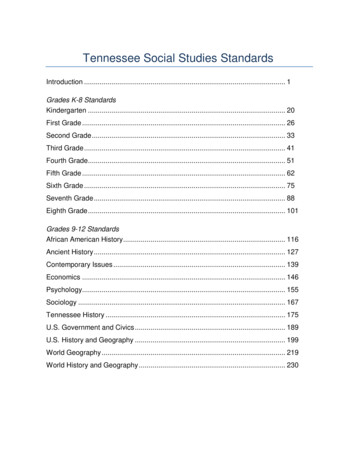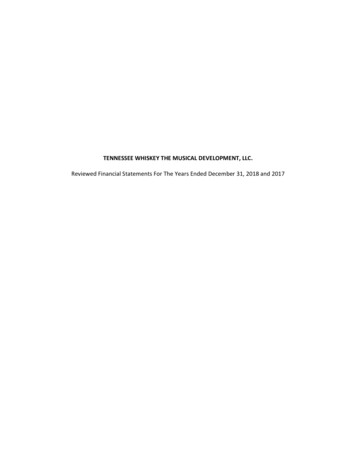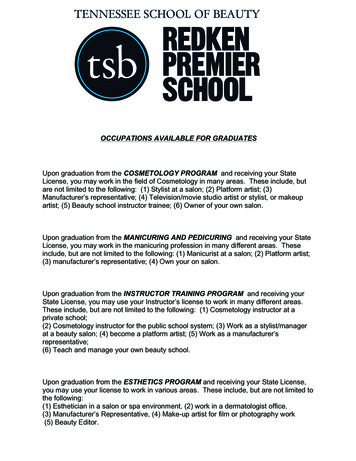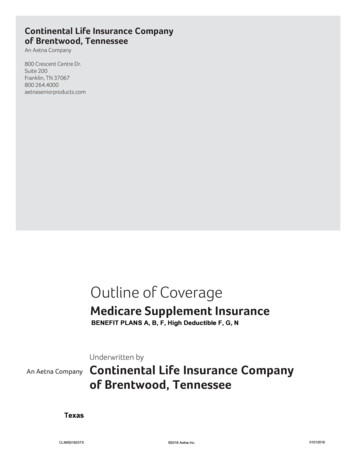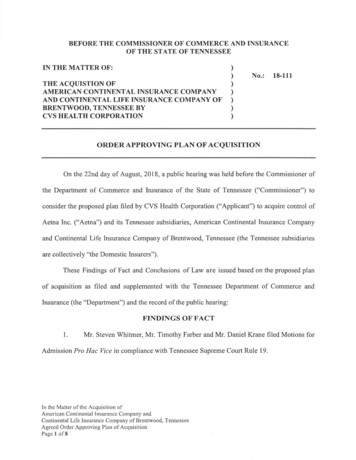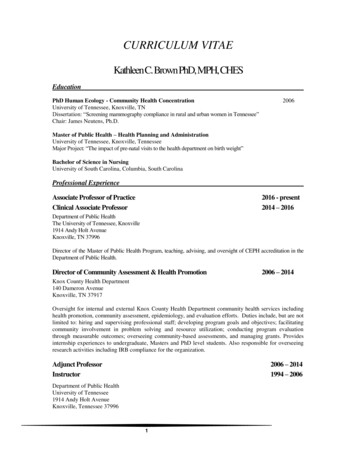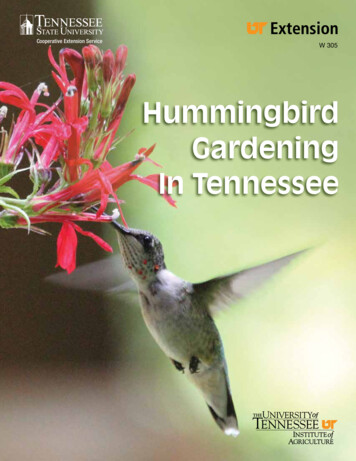
Transcription
Cooperative Extension ServiceW 305HummingbirdGardeningIn Tennessee1
ContentsIntroduction3Habitat3Ruby-throated Hummingbird Calendar4Spring Migration: Late March Through Mid-May4Tennessee Nesting Season: Early May Through July4Fall Migration: Early July Through October5Winter: November Through Late March5Importance of Insect Food5Importance of Flower Nectar Food6Different Flowers for Different Seasons —The Hummingbird Gardener’s Calendar6Early Spring6Late Spring to Early Summer7Summer7Late Summer Into Fall8Winter Hummingbirds8Hummingbird Feeders8Water, Perches, Shelter and Safety in the Garden9References10Articles10Internet Website Resources10Books11Hummingbird Plant List for Tennessee12About the Plant List12Appendix A. Favorite Flowering Plants for Hummingbirds in Tennessee13Appendix B. Additional Native Plants Visited by Hummingbirds in Tennessee15Cover photo by Vickie Henderson. Immature male ruby-throated hummingbird (red-speckledthroat) feeding from cardinal flowers (Lobelia cardinalis) in late summer.Young males don’t startgetting their red throats until late summer.2
Hummingbird GardeningIn TennesseeEmily Gonzalez, UT/TSU ExtensionMarcia L. Davis, UT/TSU Extension Master GardenerRIntroductionRuby-throated hummingbirds never fail to delight hummingbird enthusiastswho eagerly await the arrival of the first migrants each spring. Ruby-throatswinter in southern Mexico and Central America and arrive in Tennessee asearly as late March. The tiny ruby-throat is the only hummingbird species tonest in Tennessee. Although many migrant Ruby-throats remain in Tennesseeto nest each spring, most are just passing through on the way to morenorthern breeding areas extending into Canada.It is not difficult to attract migrating ruby-throats into your yard. The secret isto enhance your yard with flowers and other plantings and to provide severalhummingbird basic necessities. Ruby-throats require an abundance of bothnectar-bearing flowers and insects for food. They also need water, perches,shelter and nest sites. The sugar and water solution in hummingbird feederssubstitutes for nectar from flowers. Feeders can attract hummers into youryard and help the birds meet their very high energy requirements.HabitatTo attract hummingbirds, it’simportant to understand the keyfeatures of their habitat. Ruby-throatedhummingbirds often nest in forestsand woodlands or near the edges offorests and woodlands during springin Tennessee. Nest materials includethistle, dandelion down, soft plantfibers, rootlets, tree sap and animalhair. The tiny nest, bound together withspider webs and camouflaged withlichen, is often anchored to the fork ofa downward-sloping tree branch witha canopy of leaves above. Nestingruby-throats are most abundant inTennessee’s bottomland forests nearrivers, streams, ravines and other wetareas where insects are more abundant.photo: Marcia DavisFlower nectar and insects are themain foods of ruby-throats. Insectsand other small invertebrates make upabout 50 percent of the daily diet andup to 75 percent during the nestingseason. Wooded areas with lots of leafyvegetation near water usually supportmore insects than other areas.If your yard is not near a wooded area,or it lacks small insects and nectarrich flowers for food, you may not seehummingbirds in your yard during theAdult male ruby-throat with solid red throat.3
nesting season. However, you should be able to attractthem during migration with flowers and hummingbirdfeeders if your neighborhood has enough patches ofwoods, trees, shrubs, meadows, weeds and nectarproducing flowers. Habitat quality for ruby-throatsaround your home — including the quantity of foodavailable from flower nectar, hummingbird feeders,and insects — will influence when and how manyhummers visit your yard.photo: Vickie HendersonRuby-ThroatedHummingbird CalendarTypically, you will attract the most hummers into youryard during midsummer after young hummingbirdsfledge and during fall migration when people see largenumbers of ruby-throats at nectar-bearing flowers andhummingbird feeders. Fewer hummers are seenin spring.Female ruby-throat feeding from ‘Million Bells’ (Calibrachoa)By understanding the annual activity cycle of ruby-throats, you can create a flower gardenemphasizing nectar-bearing hummingbird plants that bloom and attract the most hummers duringthe two migration periods: spring and midsummer through early fall. These are the two periodswhen the most hummingbirds will visit your yard, and providing an abundance of nectar duringthese times will help keep them well fed.SPRING MIGRATION: Late March Through Mid-MayThe earliest spring migrants arrive in Tennessee by late March. Though many people may notsee their first hummingbird until about the second week in April, the migrants will continue topass through until approximately mid-May. The timing of migration is why it is important to puthummingbird feeders up by April 1 each year.TENNESSEE NESTING SEASON: Early May Through JulyHummingbirds may reuse their old nests the following year. It is important to note that bothnests and eggs are protected by federal and state laws and must never be collected. Hummerswill begin laying eggs in early May and laying peaks by the second half of the month. By lateMay there are nests with young nestlings. The young fledglings will start appearing out of thenest by mid-June.Don’t worry if you don’t see hummingbirds during the month of May. Adult femalehummingbirds are busy catching protein-rich insects and may visit feeders less frequently whilenesting and feeding nestlings. Unless a hummingbird is maintaining a nesting or feeding territorynear your yard, you may not see any hummingbirds during nesting season. You can expect feederand flower visits to increase after nestlings leave the nest. Nonetheless, keeping your feederstocked can provide necessary calories during this time.4
FALL MIGRATION: Early July ThroughOctoberHummingbirds must constantly replenish their fatreserves during migration. They feed heavily on flowernectar and sugar water from feeders as they continueon their journey. Planting a garden with lots of nectarrich hummingbird favorites that bloom during thisperiod will attract migrants.In contrast to spring when migrating hummers passRuby-throat feeding on Lantanathrough an area quickly because they’re in a hurry toget to the breeding grounds, fall migration is moreleisurely and stretched out over a longer period of time. This means better hummingbirdwatching with more birds. Migrant hummer numbers often peak between mid-August and earlySeptember in Tennessee.WINTER: November Through Late MarchEvery winter, a few hummingbirds nesting in the western U.S. and Canada show up in Tennesseeand other southeastern states. Most are rufous hummingbirds, but rarer possibilities includeblack-chinned, Allen’s, Anna’s, Calliope, and broad-tailed hummingbirds. Only rarely doesa winter hummer turn out to be a ruby-throat. Winter hummers often select yards with lateblooming, nectar-bearing flowers such as salvias and lots of evergreen trees and shrubs thatprovide winter cover for insects and for wintering hummers.Importance of Insect FoodCreating and maintaining good ruby-throat habitat involves encouraging insects to live in youryard. Ruby-throat food includes mosquitoes, spiders, gnats, fruit flies, small bees, larvae, aphidsand insect eggs. Small soft-bodied insects provide hummers with protein not available fromflower nectar.Ruby-throats eat small insects that are attracted to flowers and they also explore plant foliage toglean insects from leaf and bark surfaces. In early spring, hummingbirds eat insects attracted tosap from wells drilled in trees by yellow-bellied sapsuckers. Hummers also act like flycatchersand snatch small insects out of midair.You can encourage insects to live in your yard by establishing an un-mowed, natural area withtall grasses and self-established plants to attract insects. Almost any type of foliage provides ahome for insects, so if you want hummingbirds, fill your yard with plants. Purple coneflowersand bee balm both produce nectar that attracts many small insects suitable for hummingbirdfood. Trees with mushy, rotting fruit attract many different insect-eating birds. Hummers maydefend feeding territories around fruit trees, like crabapples, when lots of small insects areattracted to the rotting fruit.5photo: Vickie HendersonFall migration is when you will see the mosthummingbirds. The population is greatest in latesummer because of the addition of recently hatchedyoung birds. Each successful nest usually producestwo young hummers.
Another way to attract hummingbirds is to use a homemade fruit fly feeder. Stock a widemouthed plastic jug — opening to the side — with pieces of banana, cantaloupe and scraps ofother fruits, and place it within sight of a hummingbird feeder. Hummers will fly in to pick offtiny fruit flies or other insects feeding on the rotting fruit.One of the most important things you can do to provide insect food for hummingbirds and tokeep birds healthy is to avoid unnecessary use of pesticides. Besides killing beneficial insectsand other invertebrates used for food by hummers and many other birds, broad-spectrumpesticides might sicken birds that eat poisoned insects.Importance of Flower Nectar FoodFlowers favored by hummingbirds share characteristic colors and shapes. Many hummingbirdpollinated plants have red flowers. In addition to red, hummingbirds are also attracted to purple,hot pink, orange, blue, as well as white and yellow. Many of the tubular and trumpet-shapedflowers that hold more nectar than other flowers are irresistible to hummers. The birds hoverwhile inserting long bills and tongues into the throats of tubular flowers to reach the nectar.Pollination occurs after pollen rubs off onto a hummingbird’s head and is carried by the hummerto other flowers of the same species. Both plants and hummingbirds benefit from thisage-old relationship.Other important factors in flower selection by hummers include nectar concentration, nectarvolume and corolla (flower tube) length. Nectar consists mainly of sugar, water and salts.Hummers seem to show a preference for flowers with a nectar concentration of 20-30 percent,ample nectar supplies, and flowers with longer corollas (i.e., tubular shaped) to ensure thatcompetition for nectar from other pollinators is limited. By choosing flowers that are limited toother pollinators, such as bees, hummingbirds can maximize the amount of nectar they collectwith each energy intensive visit.Many different nectar-bearing flowers attract hummers. However, you don’t need to plant vastvarieties of flowering plants. The goal is to provide a constant supply of nectar-bearing flowersfrom early spring through late fall. Get started by focusing on some easy-to-grow plants that arebest suited for your growing conditions. Consider plants native to Tennessee that produce a lotof nectar, such as jewelweed and trumpet creeper. Hummingbirds seem to remember locations offlower gardens and feeders, often returning to highly rewarding locations the following year.Different Flowers for Different Seasons —The Hummingbird Gardener’s CalendarEARLY SPRINGWhen ruby-throated hummingbirds first arrive in early spring, welcome them with nativewildflowers. By including native plants in your garden, you will observe the mutually beneficialassociation that has existed between hummingbirds and Tennessee’s native plants for hundredsof years. Perennials like wild columbine and wild blue phlox are early spring favorites. Plantcolumbine with its drooping pendants of red-orange and yellow, as well as pink tubular flowers6
in a rock garden or semi-shaded area. Wild blue phlox is lovely when it spreads throughout amoist, shaded garden. Early blooming crossvines and yellow Carolina jessamine are ideal ona trellis, arbor or post. Flowering quince and azaleas also attract hummers. Another option is asmall native tree, Aesculus pavia (red buckeye). Red buckeye is covered with red tubular flowersthat hummingbirds depend on for nectar as they migrate north each spring.When the hummers first return it’s too early to plant annuals due to danger of frost. However, ahanging basket with brilliant red fuchsia or a cascading mass of red petunia-shaped Million Bells(Calibrachoa) along with a red hummingbird feeder will attract attention. If the planters arehung so that they are visible from above it will encourage hummers to check out your yard. Justbring hanging baskets indoors when the temperature drops too low.LATE SPRING TO EARLY SUMMERLate April is the time to plant a variety of ornamental annualsto provide a succession of nectar-rich flowers to supporthummingbirds from spring until late fall. Imagine your yard fromabove, a bird’s eye view as a hummer would see it, and create atarget of bright red color to draw them in like a beacon.Consider accenting the garden with window boxes, hangingbaskets and large flower pots. Fill them with brightly coloredpetunias, fuchsias and geraniums. Try coral honeysuckle on alamppost or mailbox. This plant will provide copious amounts oftubular coral trumpets that may bloom from mid-spring to fall.Favorite spring wildflowers include penstemons and pinks.Hummers also love the red or pink star-clustered flowers of pentas.photo: Marcia DavisHummingbirds seem to associate the color red with nectar-richfood sources. Indian pink is a red and yellow option for shadyareas. Lantana, especially in shades of red, coral, pink, orange andyellow, is a favorite for sunny areas.Trumpet honeysuckle (Lonicera sempervirens)SUMMERA bed of bee balm is a must for an open sunny area. Each redflower head is a mass of tiny, nectar-bearing tubes. Butterflybush in shades of purple, lilac, white or yellow is a favorite forits long-lasting flowers. It also attracts butterflies, as do manyof the hummingbird plants. Include a showy hibiscus,spreading mounds of verbena, or tall graceful lilies.7photo: Vickie HendersonSummer is the season for hummingbird vines. Both cypressvine and cardinal climber provide an abundance of small,tubular, red flowers. Plant them in a hanging basket or on atrellis, or let them cascade over the railing of a deck or a wall.Orange trumpet creeper, the classic hummingbird vine, isanother excellent choice.Ruby-throat feeding on pineapple sage (Salvia elegans)
LATE SUMMER INTO FALLThe greatest numbers of hummingbirds are usually observed in latesummer and early fall. They feed heavily and “tank up” in preparation forfall migration, which takes some on a nonstop flight across the Gulf ofMexico to wintering grounds. Masses of cardinal flowers and butterflyweed are favorite wildflowers for late summer and early fall. Lantana andmarigolds also persist during this time as they are drought-tolerant heatlovers in Tennessee and are growing with a full spread. Choose thebrightly colored orange and red varieties to attract the most attentionfrom hummers. In shady moist areas, patches of Impatiens capensis,(orange Jewelweed) a native wildflower, have been known to attracthummers in droves.photo: Marcia DavisEven a small, sunny apartment balcony or porch has enough space for ahummingbird garden. Blanket a railing with cypress vine, cover a trelliswith mandevilla, add a few hanging baskets, and put out a large containerof lantana. Don’t forget the hummingbird feeder.Jewelweed (Impatiens capensis)WINTER HUMMINGBIRDSMost ruby-throated hummingbirds leave Tennessee by lateOctober, but every fall a few rufous hummingbirds arrive inTennessee and spend part or all of the winter here. Lateblooming salvias and other flowers provide nectar for thesehummers until the first killing frost; then hummingbird feedersand insects will support the birds until they depart.photo: Marcia DavisSalvias are a must for any hummingbird garden. Salviacoccinea has several cultivars including hummingbird favorites‘Coral Nymph’ and ‘Lady in Red.’ Plant it in spring from apotted plant and enjoy the blooms throughout summer andeven into fall, if deadheaded. Autumn sage and pineapple sage,with their scented leaves, bloom in spring as well as into fall.Mexican bush sage, with its very unusual purple velvetyspikes, is another late bloomer. Anise sage is another fallflowering favorite.Anise sage (Salvia guaranitica)Hummingbird FeedersWhile nectar-rich flowers that also attract insects are a preferred food source for hummingbirds,hummingbird feeders have their role in the garden. A hummingbird feeder filled with a solutionof sugar and water is a substitute for nectar from flowers when flowers are scarce or foodcompetition is high. By supplementing a hummer’s natural diet of nectar and insects, properlymaintained feeders help hummers meet their very high energy requirements, especially duringpeak migration periods.The standard recipe for hummingbird feeders mimics the preferred range of nectar solutionfound in favorite hummingbird flowers (between 20 and 30 percent). This sugar-water solutionis made of 1 cup white cane sugar dissolved in 4 cups of water. Use room temperature water andstir well. Heating or boiling the water is not necessary. Using red dye might attract the birds but8
Hummingbird feeders require maintenance. Whentemperatures exceed 90 degrees, the solution must bechanged every two days. Higher temperatures encouragespoilage and growth of black mold that may sickenbirds, so do not offer more than will be eaten in a fewdays. Place feeders in the shade of trees and under eaves.Remember to rinse feeders in plain water and clean asnecessary every time you change the nectar.Most problems with hummingbird feeders are easy toprevent if you take care not to allow any nectar to get onthe outside of the feeder, which can attract unwantedChoose easy-to-clean feeders that discourage bees fromreaching sugar-water.insects. Prior to purchase, be sure to investigate whichfeeders do not leak and buy feeders that are easy to takeapart and clean. After filling or after strong winds that may cause feeders to swing and slosh,wipe feeders with a wet paper towel. You also can choose feeders that do not have yellowflowers, a favorite color for bees. Ant guards filled with water or feeders with built-in ant moatssolve ant problems as long as feeders are not in direct contact with plants. Consult your localbird supply store to find a suitable feeder for hummers.Water, Perches, Shelter and Safety in the GardenIn addition to flowers, insects and a hummingbird feeder, hummers will look for a few otherthings in your yard. All birds need water and hummers are no exception. Hummingbirds getmost drinking water from nectar, but they also need water to bathe. Hummers bathe in veryshallow water, about 1/4-inch deep, in small birdbaths and shallow pans. They also bathe byflying back and forth through a very fine spray produced by a mister or garden hose. After a rain,they like to leaf bathe by squirming around in small pools of water remaining on the surfaces oflarge leaves. For this reason, incorporate plants with large broad leaves shaped to hold a littlewater. Make sure you wet the leaves with a hose during dry spells.Because their feet are so tiny, hummers require plants with small branches for perching whilethey rest and scan for small insects. Branches about the thickness of an old-fashioned wire coathanger are ideal. Shrubs with many thin branches, such as forsythia and butterfly bush, and treeswith many tiny bare twigs are used as perch sites. Hummers often have a favorite perch theyuse repeatedly.Evergreen trees and shrubs provide hummingbirds with shelter from wind and rain, roostingsites, and protection from predators. Good cover is a basic requirement for all birds. Whencreating a landscape, include evergreens to enhance habitat for ruby-throats.Reducing hazards in your yard also can help protect hummingbirds. Outdoor domestic catsand some dogs may kill low-flying hummingbirds. If you have outdoor cats, you can planthummingbird plants in hanging baskets instead of planting them in the ground to protect thehummers while they feed.9Photo: Billie Cantwellis not necessary and may even be harmful. Store extrasugar-water in the refrigerator, but always let it reachroom temperature before serving it to hummers.
Hummers and other birds mistake landscapes reflected in windows for the real world. They mayfly to reflections of plants, hit the glass, and suffer injuries or die. For this reason, do not placehanging baskets and containers planted with hummingbird flowers in locations where they createreflections in windows.If you provide a good combination of their basic requirements, hummers will likely rememberthe location of your home and return the following year. Be sure to include some of Tennessee’snative, nectar-rich, perennial wildflowers and shrubs, especially plants with many small flowers.Providing these kinds of flowers in your landscape will provide food for many years andencourage hummingbirds to visit your garden each season.ReferencesArticlesGarrison, J. S. E. & Gass, C. L. (1998). Response of a traplining hummingbird to changes innectar availability. Behavioral Ecology (pp. 714-725).Heyneman, A. J. (1983). Optimal sugar concentrations of floral nectars. Dependence on sugarintake efficiency and foraging costs. Oecologia (pp. 198-213).Miller, R. S. & Miller, R. E. (1971). Feeding activity and color preference of ruby-throatedhummingbirds. The Condor (pp. 309-313).Roth, S. (2008, September/October). Hummingbird favorites. Fine Gardening (pp. 44-48).Internet Website ResourcesAmerican Bird Conservancyhttp://www.abcbirds.orgCats indoors, pesticides, herbicidesFine Gardeninghttp://www.finegardening.comPlant databaseHummer/Bird Study Grouphttp://www.hummingbirdsplus.orgHummingbirds, winter hummingbird Hummingbirds, migration maps, species profiles, frequently asked questionsHummingbird Societyhttp://www.hummingbirdsociety.orgDedicated to international understanding and conservation of hummingbirds10
Lady Bird Johnson Centerhttp://www.wildflower.orgPromotes cultivation and conservation of native plants, provides publications, information onsources of wildflower seeds and nursery stock.Missouri Botanical Gardenhttp://www.missouribotanicalgarden.orgPlant databaseUSDA PLANTS Databaseplants.usda.gov/java/BooksBarnes, Thomas G. (1999). Gardening for the Birds. University Press of Kentucky.Carman, Jack B. (2001). Wildflowers of Tennessee. Highland Rim Press.Day, Susan, & Rovansek, Ron, & Griggs, Jack (2003). The Wildlife Gardener’s Guideto Hummingbirds and Songbirds from the Tropics: A Cornell Bird Library Guide.HarperCollins Publishers.Hunter, Margie (2002). Gardening with the Native Plants of Tennessee: The Spirit of Place.University of Tennessee Press.Newfield, Nancy L., & Nielsen, Barbara (1996). Hummingbird Gardens: Attracting Nature’sJewels to Your Backyard. Houghton Mifflin.Nicholson, Charles P. (1997). Atlas of the Breeding Birds of Tennessee. University ofTennessee Press.Sargent, Robert (1999). Wild Bird Guides: Ruby-throated Hummingbird. Stackpole Books.Stokes, Donald, & Stokes, Lillian (1989). The Hummingbird Book: The Complete Guide toAttracting, Identifying, and Enjoying Hummingbirds. Little, Brown and Company.Williamson, Sheri L. (2000). Attracting and Feeding Hummingbirds. T. F. H. Publications.Williamson, Sheri L. (2001). Hummingbirds of North America. Peterson Field Guides.Houghton Mifflin Company.11
Hummingbird Plant List For TennesseeAbout the Plant ListReaders of the Knoxville News Sentinel’s Birdlife column, birdwatchers, members of theTennessee Ornithological Society across the state, and gardeners were asked to share informationabout favorite hummingbird plants that grow in Tennessee. The Tennessee hummingbird plantlist was compiled by Meredith Clebsch, Marcia Davis, Emily Gonzalez and Terumi SaitoWatson and was edited by Emily Gonzalez and Carol Reese, Ph.D. While these plant listsare not exhaustive, they do contain many of the favorite plants visited by the ruby-throatedhummingbird in Tennessee that are available to the home gardener (See Appendix A and B).We listed colors that are commonly available; however, depending on the species other colorsmay be available as well. Some of the genera listed contain multiple species that would bevisited by hummingbirds and do well in our area; in that case we listed the genus name followedby species (spp). We also recognized that many wildlife gardeners try to create what theyconsider “native habitat,” so we also listed specific native species that we would recommend. Asproper soil is the foundation for healthy plants, we took extra effort to list conditions that wouldbe favored by each species rather than just tolerated, although many of these plants will growin a variety of conditions. We referenced the USDA PLANTS database in an attempt to use the“standard” nomenclature for these plants.12
Appendix A. Favorite Flowering Plants for Hummingbirds in TennesseeA AnnualSP SpringLav LavenderP PinkY YellowSeparate flower colors are indicated by (,) Full SunP PerennialS SummerPP PurpleW WhiteO OrangeAggregate colors are indicated by (/) Part SunF FallR RedPlantCommon NameColor(s)SeasonHabitNativeA/PLight ShadePreferred Soil ConditionsAesculus paviaRed buckeyeRSPTreeYesPmoist, well-drained fertile soilAgastache ‘DesertSunrise’Hummingbird mintP,R,OSForbNoPdry to moist, fertile, well-drainedsoilAntirrhinum majusSnapdragonR,P,PP,OSForbNoPmoist, well-drained loamAquilegia canadensisWild columbineR,P,YSPForbYesPmoist, well-drained loamAsclepias tuberosaButterfly weedOSForbYesPdry to moist, poor to average, welldrained soilBignonia capreolataCrossvineR,Y,OSPVineYesPmoist, well-drained soilBuddleia davidiiButterfly bushO,PP,W, YSShrubNoPdry to moist, well-drained soilCalibrachoa ‘Million Bells’ ‘Million Bells’P, Y, PP, W,O, RS,FForbNoAmoist, well-drained soilCampanula persicafoliaPeachleaf bellflowerBSForbNoPmoist, well-drained soilCampsis radicansTrumpet creeperR,OSVineYesPpoor to average, dry to moist soilCanna generalisCanna lilyR,O,YSP,SForbNoPmoist, well-drained loamChaenomeles spp.Flowering quinceR,P,WSPShrubNoPmoist, well-drained soilCleome hasslerianaSpider flowerP,PP,WS,FForbNoAdry to moist, well-drained soilCuphea igneaFirecracker plantRS,FForbNoAmoist, well-drained loamEpilobium angustifoliumFireweedPSForbYesPdry to moist, well-drained soilFuchsia sppFuchsiaP/PP, R/PPSForbNoAmoist, well-drained fertile loamGelsemium sempervirensCarolina jessamineYSPVineYesPmoist, well-drained loamGlandularia canadensisVerbena, rose mockvervainPP,PSForbYesPdry to moist, well-drained soilHemerocallis fulvaDaylilyR,O,YSForbNoPdry to moist, well-drained soilHeuchera sanguineaCoralbellsRSPForbNoPmoist, well-drained loamHibiscus sppHibiscus (hardy)R,P,PP,Y,WSShrubNoPmoist, well-drained loamHibiscus syriacusRose of SharonR,P,W,PPSShrubNoPmoist, well-drained loamHosta sppHostaW,LavSForbNoPmoist, well-drained loamImpatiens capensisJewelweedO,YS,FForbYesAmoist to wet, clay or loamIpomoea quamoclitCypress vineRS,FVineNoAmoist, well-drained soilIpomoea x multifidaCardinal climberRS,FVineNoAmoist, well-drained soilKniphofia uvariaRed-hot pokerR,OSPForbNoPmoist, well-drained loamLantana sppLantanaR,O,P,YSP,S,FForbNoAdry to moist, well-drained soilLilium superbumTurk’s-cap lilyOSForbYesPmoist to wet, well-drained loamLobelia cardinalisCardinal flowerRS,FForbYesPmoist to wet, well-drained loamLobelia siphiliticaGreat blue lobeliaBSForbYesPmoist to wet, well-drained loamLonicera sempervirensTrumpet honeysuckleRSP,S,FVineYesPmoist, well-drained loamMandevillaMandevillaPS,FVineNoA/Pmoist, well-drained loamMonarda didymaBee balmRS,FForbYesPmoist to wet loam13
Appendix A. Favorite Flowering Plants for Hummingbirds in Tennessee (continued)A AnnualSP SpringLav LavenderP PinkY YellowSeparate flower colors are indicated by (,) Full SunP PerennialS SummerPP PurpleW WhiteO OrangeAggregate colors are indicated by (/) Part SunF FallR RedPlantCommon NameColor(s)SeasonHabitNativeA/PLight ShadePreferred Soil ConditionsMonarda fistulosaWild bergamotP,LavSForbYesPdry to moist, well-drained soilNicotiana alataFlowering tobaccoR,P,WSForbNoAmoist, well-drained loamPelargoniumGeraniumR,O,P,PPS,FForbNoAdry to moist, well-drained soilPenstemon smalliiSmall’s beardtonguePPSPForbYesPdry to moist, well-drained loamPentas lanceolata ‘New LookRed’Egyptian star clustersRSP,SForbNoAmoist, well-drained loamPetuniaPetuniaR,P,PP,WSP,S,FForbNoAmoist, well-drained soilPhaseolus coccineusScarlet runner beanRSVineNoAmoist, well-drained soilPhlox divaricataWild blue phloxB,LavSPForbYesPmoist, well-drained loamPhlox paniculataSummer phloxR,P,W,PPSForbYesPmoist, well-drained fertile soilPhysostegia virginianaObedient plantP,WS,FForbYesPmoist, well-drained soilPlatycodon grandiflorumBalloon flowerPPSForbNoPmoist, well-drained soilRhododendron calendulaceumFlame azalea(east TN)O,Y,RSPShrubYesPmoist, acidic, well-drained loamRhododendron canescensMountain azalea (eastTN)P,WSPShrubYesPmoist, acidic, well-drained loamRhododendron catawbienseCatawba rhododendron(east TN)PPSPShrubYesPmoist, acidic, well-drained loamRhododendron sppRhododendron (eastTN)SPShrubPmoist, acidic, well-drained loamRibes odoratumGolden currantYSPShrubNoPmoist, well-drained loamSalvia greggiiAutumn sagePP,PS,FForbNoPmoist, well-drained soilSalvia coccineaBlood sage, Texas sageRS,FForbNoAmoist, well-drained soilSalvia elegansPineapple sageRFForbNoSalvia farinaceaMealy-cup sageB,PPS,FForbNoAmoist, well-drained soilSalvia guaraniticaAnise sageBS,FForbNoPmoist, well-drained soilSalvia leucanthaMexican bush sagePP,WS,FForbNoPmoist, well-drained soilSalvia splendensScarlet sageRS,FForbNoAmoist, well-drained soilSilene carolinianaSticky catchfly, Carolina PpinksSPForbYesPdry to moist, well-drained soilSilene regiaRoyal catchflyRSForb
wildflowers. By including native plants in your garden, you will observe the mutually beneficial association that has existed between hummingbirds and Tennessee’s native plants for hundreds of years. Perennials like wild columb

